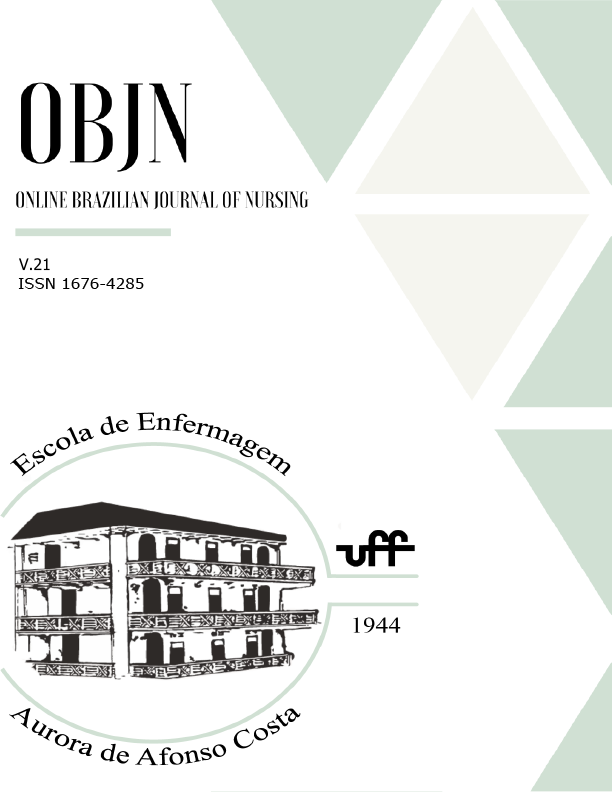Abstract
Objective: To describe the use of Virtual Reality during venipuncture procedures in hospitalized children. Method: A descriptive study with a quantitative approach, carried out through observation of venipuncture procedures in children using Virtual Reality glasses at a pediatric inpatient unit of a hospital in the Northwest region of Paraná. The data were collected from August to September 2019. Results: A total of 16 children were observed, aged between four and eight years old and who were subjected to the procedure along with use of the glasses. The pain scores were predominantly mild in both age groups and the most evident psychomotor behavior was minor discomfort. Conclusion: The study showed that the punctures performed using Virtual Reality presented mild pain scores and that, in terms of pain management, its use can be a beneficial alternative within pediatric care in the performance of painful procedures.
References
Faccioli SC, Tacla MTGM, Rossetto EG, Collet N. The management of pediatric pain and the perception of the nursing team in light of the Social Communication Model of Pain. BrJP. 2020;3(1):37-41. https://doi.org/10.5935/2595-0118.20200009
Costa T, Rossato LM, Bueno M, Secco IL, Sposito NPB, Harrison D, et al. Nurses’ knowledge and practices regarding pain management in newborns. Rev Esc Enferm USP. 2017;51:e03210. https://doi.org/10.1590/S1980-220X2016034403210
Ulisses LO, Santos LF, Araújo CN, Oliveira EF, Camargo CL. Pain management in children as perceived by the nursing team. Rev Enferm UERJ. 2017;25:e15379. http://dx.doi.org/10.12957/reuerj.2017.15379
Guimarães LGS, Binotto NS, Ederli SF, Tacla MTGM. Manejo da dor em punção venosa pediátrica: um pacote de medidas. Recien. 2021;11(33). https://doi.org/10.24276/rrecien2021.11.33.157-168
Silva AC, Silva TP, Alves DN, Amarante LH, Góes FG, Goulart MC. Prática clínica da equipe de enfermagem acerca da terapia intravenosa em unidade neonatal e pediátrica. Rev Baiana Enferm. 2019;33:e3382. http://dx.doi.org/10.18471/rbe.v33.33828
Kamel FA, Basha MA. Effects of virtual reality and task-oriented training on hand function and activity performance in pediatric hand burns: a randomized controlled trial. Arch Phys Med Rehabil. 2021;102(6):1059-66. https://doi.org/10.1016/j.apmr.2021.01.087
Scapin S, Echevarría-Guanilo ME, Fuculo-Junior PR, Gonçalves N, Rocha PK, Coimbra R. Virtual reality in the treatment of burn patients: a systematic review. Burns. 2018;44(6):1403-16. https://doi.org/10.1016/j.burns.2017.11.002
Strengthening the Reporting of Observational Studies in Epidemiology (STROBE). What is STROBE [Internet]. [place unknown]: STROBE; 2022 [cited 2022 jan 01]. Available from: https://www.strobe-statement.org/
Freitas DM, Spadoni VS. A realidade virtual é útil para manejo da dor em pacientes submetidos a procedimentos médicos? Einstein. 2019;17(2):eMD4837. http://dx.doi.org/10.31744/einstein_journal/2019MD4837
Xiang H, Shen J, Wheller KK, Patterson J, Lever K, Armstrong M, et al. Efficacy of smartphone active and passive virtual reality distraction vs standard care on burn pain among pediatric patients: a randomized clinical trial. Jama Netw Open. 2021;4(6):e2112082. https://doi.org/10.1001/jamanetworkopen.2021.12082
Bussotti EA, Guinsburg R, Pedreira MLG. Cultural adaptation to Brazilian Portuguese of the Face, Legs, Activity, Cry, Consolability revised (FLACCr) scale of pain assessment. Rev Latino-Am Enferm. 2015;23(4):651-9. https://doi.org/10.1590/0104-1169.0001.2600
Sedrez ES, Monteiro JK. Pain assessment in pediatrics. Rev Bras Enferm. 2020;73(Suppl 4):e20190109. http://dx.doi.org/10.1590/0034-7167-2019-0109
Hampton AJD, Hadjistavropoulos T, Gagnon MM. Contextual influences in decoding pain expressions: effects of patient age, informational priming, and observer characteristics. Pain. 2018;159(11):2363-74. https://doi.org/%2010.1097/j.pain.0000000000001345
Cunha ML, Brandi S, Bonfim GF, Severino KG, Almeida GC, Cunial PC, et al. Application program to prepare child/family for venipuncture: experience report. Rev Bras Enferm. 2018 ;71(Suppl 3):1474-1478. https://doi.org/10.1590/0034-7167-2017-0386
Silva TP, Silva LJ, Silva IR, Ferreira MC, Costa LS, Leite JL. Assessment and management of chronic oncologic pain in a pediatric inpatient unit. Rev Enferm UFSM. 2021;11(e31):1-21. https://doi.org/10.5902/2179769247865
Amponsah AK, Kyei EF, Agyeman JB, Boakye H, Kyei-Dompim J, Oduro E. Nursing-related barriers to children’s pain management at selected hospitals in ghana: a descriptive qualitative study. Pain Res Manag. 2020;12:1-6. https://doi.org/10.1155/2020/7125060
Dascal J, Reid M, IsHak WW, Spiegel B, Recacho J, Rosen B, et al. Virtual Reality and medical inpatients: a systematic review of randomized, controlled trials. Innov Clin Neurosci. 2017;14(1/2):14-21. https://doi.org/28386517
Michael SH, Villarreal PM, Ferguson MF, Wiler JL, Zane RD, Flarity K. Virtual reality based resilience programs: feasibility and implementation for inpatient oncology nurses. Clin J Oncol Nurs. 2019 ;23(6):664-667. https://doi.org/10.1188/19.CJON.664-667
Scapin S, Echevarría-Guanilo ME, Funculo Junior PR, Tomazoni A, Gonçalves N. Virtual reality as complementary treatment in pain relief in burnt children. Texto Contexto Enferm. 2020;29:e20180277. https://doi.org/10.1590/1980-265X-TCE-2018-0277

This work is licensed under a Creative Commons Attribution 4.0 International License.
Copyright (c) 2022 Array

